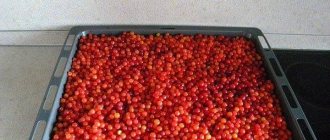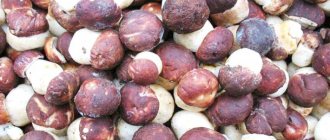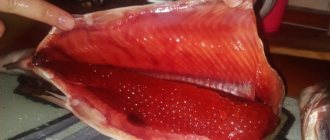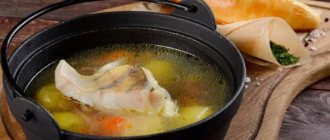Mackerel: how to store it correctly
Storage conditions depend on what kind of fish you purchased. For this reason, it is worth talking about storing each type of mackerel separately.
Fresh mackerel
Only those who live in the regions where it is caught can afford to buy fresh mackerel. If you have such an opportunity, then purchase carcasses with the head. Spoiled fish are often sold without the head, so that the buyer cannot determine by the eyes and gills of the mackerel that it is stale.
Fresh mackerel is best stored in the refrigerator. There it will remain fresh for 24 hours. In its purified form, that is, when the insides, black film, tail and head are missing, fresh mackerel will last in the refrigerator for 2 days. Fresh fish should be stored on the lowest shelf of the refrigerator, that is, where it is coldest.
If you need to preserve fish for as long as possible, use crushed ice. In it, mackerel can not spoil for about 10–14 days.
Spring mackerel
Hanging mackerel is the type of mackerel that is hung after salting. The fish must be hung in a room that is dry and well ventilated.
Once hung, hanging mackerel can be stored for up to 2-3 days if wrapped tightly in either parchment or wax paper. If hung fish is cut into pieces and placed in a glass container with vegetable oil, then in the refrigerator at 2–4 degrees it will remain fresh for about a week.
Salted mackerel
Despite the fact that salted mackerel is not heat-treated, it is comparatively better stored than fresh fish. How long such mackerel will remain fresh largely depends on the brine in which it was cooked. At home, salted fish is stored without brine, or you prepare it yourself.
Mackerel without brine should be stored in the refrigerator in a plastic bag at 3-5 degrees - this way it remains edible for about a day. If the fish is cleaned and divided into pieces, and then poured with vegetable oil and spices, it will be stored at a temperature of 3 to 5 degrees for about 5 days.
How to choose the right mackerel
- It is easy to distinguish Atlantic mackerel by size; it will be at least 600 grams, and at a maximum it reaches a kilogram or more. You can take smaller fish, but know that they are already mackerel, so the choice is yours.
- The most important thing is to choose a fresh product: for this you need to pay attention to the color of the mackerel, there should be a green-blue stripe on top, and the belly should be white with a slight pinkish tint.
- Be sure to pay attention to the smell of mackerel, slightly fishy, but not sharp; if you smell the smell before reaching the counter, it is better to refrain from buying in this pavilion, the fish should smell fresh.
- Mackerel fishing takes place from April to November, at this time it is better to buy fresh fish, it is available in markets and supermarkets, buy frozen fish out of season.
- There should be no ice on freshly frozen mackerel, and it is frozen one by one; if you see that the fish is lying in a clump of several pieces, it is at least frozen a second time.
- Pay attention to the price of mackerel; if it is lower than usual, it means it’s definitely not worth buying, the fish may not be of high quality, and when you defrost it at home, you won’t be able to cook it and simply throw it away.
- Freshly frozen mackerel should be silver in color, without yellowness or spots on the eyes; if this is present, it means the fish is not the freshest.
It's okay if you buy frozen mackerel, just choose high-quality and fresh, and then your home-salted fish will be unsurpassed.
How to tell if a product has gone bad
There are several criteria that will help you understand for sure whether the mackerel has gone bad.
- The spoilage of mackerel is indicated by its smell. Spoiled fish has a sour, unappetizing smell.
- A dirty gray or greenish coating also indicates that rotting processes are actively developing in the fish.
- Stale mackerel becomes slippery to the touch.
- And the last aspect indicating spoilage of fish is the appearance of mold. It is extremely dangerous to eat such mackerel.
Seafood poisoning is considered the most dangerous, so always follow the storage conditions for mackerel and carefully monitor its freshness. Only in this case will the fish be beneficial and delight you with its taste.
Smoked mackerel is a sought-after delicacy that can be found on sale in several forms: with or without heads, with or without entrails. Smoking of this fish is done in two main ways - cold or hot. Depending on the smoking method, the product differs in storage conditions and shelf life.
Benefits and harms
- Salted mackerel contains vitamins A, B, D, E, K, PP, microelements such as zinc, calcium, sodium, iron, magnesium, phosphorus and others, fatty acids, and easily digestible proteins.
- Positively affects the nervous system.
- Improves vision.
- Increases the elasticity of blood vessels and capillaries.
- Reduces cholesterol levels.
- Prevents the occurrence of cancer.
- Increases hemoglobin.
- Strengthens the immune system.
- Eliminates pain from arthritis and arthrosis.
- Restores mucous membranes.
- Improves memory.
- Strengthens teeth as it contains phosphorus.
- Has a bactericidal effect.
- Relieves headaches.
- Reduces the symptoms of psoriasis.
It is not recommended to eat fish for people suffering from hypertension and obesity, as it is a fatty species and has a high calorie content. Mackerel is also contraindicated in case of allergies to seafood, liver and kidney diseases. Do not use large carcasses for salting: mercury accumulates in them.
You can learn more about the benefits of mackerel in the previous article.
How to store mackerel
This inexpensive fish is a close relative of tuna, but it is a more frequent guest on our table. This most valuable commercial fish is a healthy product, and mackerel is also good in all forms, and is sold both fresh and thermally processed in various ways. How to store mackerel that you bought as a stock, frozen or smoked for the table, or canned from it?
The most important thing about storing mackerel
Fresh, ungutted fish can be stored in the refrigerator for no more than 1 day.
Mackerel cannot be re-frozen. After defrosting again, it will fall apart.
The shelf life of cold and hot smoked mackerel varies significantly.
What is the best way to cook defrosted fish?
- It is best to cut the fish into portions after defrosting and fry it .
- Then the fish does not become too deformed when frying, and the unpleasant odors that the product absorbed while in the freezer should be overcome by the aroma of a well-fried crust.
Using one of the above methods, you can defrost fish two or even 3 times faster than with the traditional defrosting method - it all depends on the size of the fish and how correctly it was frozen.
We will also tell you how to freeze and defrost:
- Ground meat
- Chicken
- Eggs
- Meat
How to store fresh mackerel
Traditionally, mackerel is sold fresh, dry-frozen, that is, fresh frozen without ice. In this form, it can be stored in supermarkets for up to three months, after which the product is transferred to the “promotional” category and the price is reduced.
But there are regions where this fish can be bought immediately after catching. Therefore, it is important to know how long you can store fresh mackerel in the refrigerator. It is best to choose whole carcasses with the head, since the head of spoiled fish is always removed so that the quality of the eyes and gills cannot determine the spoilage of the product. The length of time you can store unpeeled mackerel in the refrigerator is 1 day.
You can also clean the mackerel from the insides, remove the head and tail, and carefully remove all the black films. Mackerel should be stored in this form in the refrigerator on the bottom shelf for a maximum of 2 days.
If possible, you can put fresh fish in crushed ice; in ice, the shelf life of mackerel at home is 10-14 days. Crushed ice can be made by freezing water in plastic cups, bottles or ice bags.
In addition, you can pickle fresh mackerel in brine yourself to avoid spoilage. The basic brine recipe contains:
- 3 tbsp. l salt;
- 2 tbsp. l sugar;
- 1 liter of water;
- additionally, for lovers of spicy tastes: 1 teaspoon of spices to taste (bay leaf, coriander, mixture of peppers).
You can salt a whole, cleaned carcass or halves of mackerel in brine; this method of storing fresh home-salted fish is suitable for conditions where there is no freezer or the ability to heat-treat mackerel. The fish will be ready in 1 day.
Salted and brine-filled fish can be stored in the refrigerator for no more than 7 days at a temperature of 4 to 6°C.
The so-called suspended mackerel is also prepared in brine, when the fish, after salting, is suspended in a dry, well-ventilated place for a certain period of time. You can store such fish by wrapping it tightly in food-grade wax paper for 1-2 days. Or cut it into small pieces, put it in a jar and fill it with oil. So the fish will stay in the refrigerator at a temperature of 2-4°C for up to a week.
There are also many recipes for dry salting mackerel. For example, fish cut into pieces about 1 centimeter thick should be rolled in salt and spices if you want to preserve the mackerel, and placed in a glass container. No water is added - this dry salting of the fish allows you to preserve all the taste qualities of the mackerel to the maximum. In 3-4 hours you will be able to cook lightly salted fish, and it will be completely ready in 1 day.
Store at a temperature no higher than +5°C for up to 3 days. You can also layer the fish with onions, add water to cover the pieces and store in a glass container at a temperature no higher than +7°C for up to 1 week.
It is also easy to turn such fish into marinated fish. To do this, it should be seasoned with vinegar, vegetable oil and onions. Since it is advisable to marinate the fish at least a few hours before serving, calculate the cooking time correctly. Many people are interested in whether it can be stored in the refrigerator for a long time. If there are onions in the marinade, it is not recommended to store longer than 2-3 days.
Ingredients
- 1 l. cold water
- 2 fresh frozen mackerel
- 2 tbsp. black tea (without additives)
- 2 tbsp. salt
- 2 handfuls of onion peels (more is possible)
- 1 tbsp. Sahara
How to cook whole salted mackerel in brine
1. First you need to start preparing the brine. Pour the required amount of salt and sugar into the pan. Take heaping tablespoons.
2. Black tea without additives.
3. Rinse the onion peel to remove sand and also add it to the rest of the components of the future brine.
4. Pour cold water over all ingredients. Place the pan on the fire and boil. Then turn off the heat, close the lid and let the brine steep so that it absorbs the aromas of onion skins and tea as much as possible and becomes rich in color. Leave until the pan is cold.
5. It is better to take larger mackerel, or if the fish are not too large, you will need to reduce the time they are kept in brine. Clean the mackerel, remove all the insides, and take special care to remove all the black films from the belly; they can add bitterness to the fish fillet. Wash the fish thoroughly, especially from the inside. The fins should not be trimmed, since many small bones are attached to them, which can then be easily removed along with the fins when cutting mackerel.
6. Cut off the heads of the fish. Strain the cooled brine and pour into a wide container suitable in size to accommodate the fish. Place mackerel carcasses in brine. Press down on top with something so that the fish does not float to the surface, but is completely immersed in the brown brine. Leave at room temperature for two days; in principle, you can start trying after 24 hours.
Interesting: If you try to cook it in a water bath, the condensed milk will not crystallize
7. During this time, the fish will be well salted and turn golden.
8. Salted mackerel is ready to eat. You should not store fish salted at home for more than a week, because no preservatives were used in its preparation, so such salted mackerel cannot be stored for a long time. Can be sliced and served.
Recipe No. 2. How to pickle whole mackerel in spiced brine
Lightly salted mackerel is the easiest way to prepare this healthy fish, preserving the maximum of nutrients in it. Mackerel is a fatty fish, which means it contains fatty acids that are so important for our body. In addition, fish is rich in a number of minerals and vitamins. Preparing lightly salted mackerel is not at all difficult. You just need to pickle it in a salty solution and add some spices. Marinating time – 24 hours. At the end we get aromatic soft fish with all its useful components. In this recipe we will brine whole mackerel in a spiced brine.
- large mackerel 1 piece;
- bay leaf 2 pcs.;
- allspice 5-6 pcs.;
- cloves 7-8 pcs.;
- salt 1-1.5 tbsp. spoons;
- boiled water 0.5 l.
Cooking sequence:
Let's boil water and cool it. Pour 0.5 liters of water at room temperature into a deep container. Add 1-1.5 tbsp to the water. spoons of table salt and stir it thoroughly until completely dissolved. The brine is ready.
Add cloves, bay leaves and allspice to the salt water.
Let's defrost large mackerel. We wash it, gut it and put it in a container with brine. We completely immerse the fish in water. We put the container in the refrigerator. We keep the fish in brine for 24 hours, longer if possible.
After the specified time, remove the fish from the brine and cut into small pieces. You can add a few rings of fresh onion. Drizzle the fish with vegetable oil and, if desired, vinegar.
Lightly salted mackerel, salted whole in brine, is ready! Soaked in cloves and allspice, it will be very fragrant.
Have you tried salting mackerel
Houses? It’s in vain, it’s not at all difficult, the salting technology is simple, and the fish turns out incredibly tasty, very aromatic and tender. And you are unlikely to buy such a fish in a store. I suggest you make salted mackerel at home using a very tasty recipe that all your guests will enjoy.
You can also choose any recipe you like from the selection and diversify your taste.
How to store frozen mackerel
We don’t know how many months the fish was stored in the warehouse before it got to the supermarket, so you shouldn’t stock up on this product for future use, filling your freezer to capacity. Storing mackerel at home in this way should not exceed a period of 2-3 months, and then only if the carcasses are undamaged. Mackerel is not suitable for long-term storage, and there is no seasonality in its sale; this fish is available all year round at the same price.
In the freezer, place the fish in a separate plastic container and wrap it in a bag. The optimal temperature for storing mackerel in the freezer is from -15...-24°C.
So that after defrosting the fish is suitable for cutting and does not fall apart under the knife, it must be defrosted correctly. To do this, place it on the bottom shelf of the refrigerator for 10-12 hours. It is also important what you use to defrost mackerel: place it in a plastic container on a wire rack so that excess moisture drains out and is not absorbed back into the fish.
Can it be re-frozen?
There are times when the amount of defrosted fish turned out to be excessive. Out of habit, the remaining fish pieces are sent back to the freezer. This is absolutely not possible. After defrosting again, the cut carcass will turn into a shapeless mass that has no aroma.
When fish is frozen, it is protected for a long time from the development of bacteria under the influence of negative temperatures.
As soon as the carcass thaws, microorganisms that have entered the product in various ways can begin to act on its surface.
Their prolonged presence on fish leads to its spoilage. Therefore, you need to defrost as much product as you need to cook for lunch.
Attention and leisure are the main helpers in defrosting fish. Using useful tips will save the housewife from spoiling the product and wasting money on purchasing a huge carcass.
Everyone knows that fish must be fresh. But, unfortunately, in Moscow, due to its geographical location, it is almost impossible to buy freshly caught sea fish.
New technologies for instant freezing of products are truly a salvation for fish and seafood lovers. Our online store sells fish that is frozen immediately after being caught. Freshly frozen fish retains all the beneficial properties, taste and smell that will delight us after proper defrosting of the product.
How to defrost fish and seafood correctly?
If freezing fish and seafood is a very fast process (the faster the better), then when defrosting, the same rule applies, only the other way around - the defrosting process should be long. Defrosting the product under the influence of hot or even warm water is excluded. Fish and seafood cook very quickly, so using even warm water along with defrosting will begin the cooking process, the proteins of the outer layer of the product will coagulate - with further heat treatment, the taste, color, density and even the composition of nutrients in the dish can change greatly.
It is also not recommended to defrost fish and seafood in cold water - vitamins, micro- and macroelements, which marine life is rich in, will partially go into the water. If there is a serious need to urgently defrost the fish in cold water (to speed up the process), then you need to pack the fish in a plastic bag so that the product does not come into contact with water. If frozen seafood is in vacuum packaging, you can, without damaging the integrity of the packaging, put it in cold water to defrost.
You should not defrost fish products in the air - in this case, the process of proliferation of bacteria and microbes may begin. In addition, you should avoid using the defrost mode in a microwave oven.
THE BEST WAY TO DEFROST FISH AND SEAFOOD is the following process:
Remove the product from the freezer and, without damaging the integrity of the packaging, transfer it to the bottom shelf of the refrigerator. When the fish or seafood has thawed, open the bag, drain the liquid, and the product can be rinsed with cold water (if it is a whole fish) and then absorb excess moisture with a dry towel. If we are talking about fish fillets or steaks, then it is better to completely avoid contact of the product with water so as not to change the chemical composition of the meat.
If fish products are not completely defrosted, it’s not a problem. Seafood can be cooked frozen; fish also does not have to be completely thawed.
It is necessary to start cooking defrosted fish or seafood as quickly as possible, before the process of proliferation of bacteria and microorganisms begins.
Food of different sizes must be given sufficient time to defrost properly. It will take about a day to defrost an entire large carcass weighing 2 kilograms. If the fish is cut into pieces, it will take much less time (depending on the size of the pieces).
With proper - slow - defrosting of fish and seafood, most of the nutrients will remain in the food. During rapid defrosting - accompanied by the release of a large amount of liquid - useful substances are released from the product along with the liquid.
The most delicious and healthy dishes are planned in advance. If you want to surprise your household with culinary delights, on the eve of this day, remove the fish from the freezer and place it on the bottom shelf of the refrigerator.
What is sautéing and is it necessary to use it? Sautéing is the gentle “boiling” of chopped vegetables in oil, when they are practically stewed and softened in fat at a low temperature.
If onions and carrots are placed raw in the broth, then during cooking the soup their essential oils will evaporate significantly, and this will worsen the taste and aroma of the soup.
Therefore, chopped onions and carrots are heated in a shallow, wide bowl with a small (15-20% of their weight) amount of fat. To ensure even heating and to ensure that each piece is covered in fat at all times, stir the vegetables periodically. , evaporating from pieces of vegetables when heated, are absorbed by the fat enveloping them.
And since vegetables become half-cooked during sautéing, they are added to the soup shortly before the end of cooking, thereby significantly reducing their stay in the boiling liquid.
The slow release of essential oils from fat ensures that the soup retains the taste and smell of vegetables not only until the end of cooking, but also for 1-2 hours after it. During sautéing, the fat turns orange, since carrot carotene is partially dissolved in it, and gives the dish an exquisite color and aroma, and also allows you to preserve vitamins A and C in vegetables.
Secrets of golden brown crust
Most often, to bread meat, fish and vegetable dishes, we use breadcrumbs, which are usually made from stale bread.
Regular crackers are equally good for cutlets and muffins.
But often garlic, dill, and various spices are added to crackers, and, of course, such crackers will spoil sweet cookies. Conversely, crackers with coconut flakes will not go well with cutlets.
The size of the breadcrumbs also matters: small ones (less than 1 mm) are similar to flour and will not give a juicy crunch; large ones (more than 2 mm) may not stick to the product at all. It is better to choose the middle one - 1.5 mm.
If the manufacturer writes that crackers can be stored for six months, it means they have added preservatives. Buy crackers that can be stored for no more than a month, and try to use them quickly.
And for those who don’t like breading, you can use another one.
* Sesame.
You can fry pieces of meat, fish, apples, bananas and pears in sesame seeds. This breading adds a spicy oriental flavor.
* Carrot shavings.
To prepare this breading, carrots need to be grated and dried in the oven. The breading will stick well if the product is first dipped in batter or egg.
* Nuts.
Nut breading not only gives the dish an appetizing look, but also makes it more filling. Products can be breaded in different nuts, having previously crushed them. The main thing is not to overcook, otherwise the nuts will lose both taste and color.
* Flakes.
Oatmeal or buckwheat flakes will complement the taste of fish dishes. Pieces of fish or cutlets need to be rolled in flour and eggs, and then in cereal. Choose small flakes; they will create a light and tender crust.
* Semolina.
Semolina complements the taste of seafood, chicken and cabbage. Dip the pieces in flour, then soak in vegetable oil or lezone (egg white or whole beaten egg, starch) and sprinkle with semolina.
* Crackers and chips.
This breading will change the taste of any cutlets, nuggets (pieces of the most tender chicken fillet breaded) and meatballs. For breading, crackers and chips need to be crushed into crumbs.
Fish secrets
Boiled fish
All types of fish are used for cooking. Boiled fish is served with boiled potatoes, salted or fresh tomatoes. Salads made from raw vegetables (grated carrots, radishes, etc.) with boiled fish are very tasty. Sauces that go well with boiled fish include: Polish, Dutch, white sauce with capers, tomato sauce. Cold horseradish sauce with vinegar and hot tomato sauce are recommended for sturgeon fish.
Fried fish
The fish is fried whole with small heads - smelt, red mullet, gobies, roach, crucian carp, small navaga, herring, small fish, lampreys, etc.; pieces - flounder, halibut, burbot, tench, ide, eel, etc.; fillet without bones and skin - pike perch, whitefish, any piece of fish; links without cartilage and skin - sturgeon, stellate sturgeon.
Dishes made from fish fried with onions (pike perch, catfish, flounder) and in dough (pike perch, sturgeon) are delicious. Flounder can also be served with a vinegar or tomato marinade, as it keeps the fried fish from drying out.
Stewed fish
For stewing, fatty and medium-fat fish are mainly used: flounder, catfish, halibut, sea bass, sablefish, pristipoma, swordfish, toothfish, carp, bream, carp, catfish, etc.
You can also stew fish with dry and dense flesh (hake, cod, large pike), as well as salted fish, which has a tougher flesh than fresh. Stew raw and pre-fried fish. Small fish are stewed whole with the head, medium-sized and large fish are stewed in pieces.
The stewed fish is served with vegetables and the sauce formed during the stewing process.
Based on their skeletal structure, fish are usually divided into two categories: round and flat; they are prepared and cut in different ways.
round fish
has a thick, round body and eyes located on both sides of the head. A ridge runs along the center of the fish, separating two thick fillets on either side. Round fish is usually filleted or cut into pieces.
Flatfish
almost two-dimensional, having both eyes on one side of the head. The ridge runs through the center of the fish, and two lines of bones extend from it on each side, separating the top and bottom fillets. Flat fish are usually filleted, but if they are very large (such as halibut), they can be chopped into pieces.
How to separate the skin from a fish fillet
The skin is removed from fillets of round and flat fish in the same way; mastering this skill is not difficult. Use a sharp knife with a long blade.
Before you begin, dip your fingers in coarse salt or hold the tail end with a kitchen towel.
Place the fillets skin side down on a cutting board. At the base of the tail, make a small cut down to the skin, then lightly separate the meat from the bone.
Pull the skin taut at the tail end. Hold the knife at a 45-degree angle to the skin and use a light sawing motion to move it between the skin and the meat. Use tweezers to remove all small seeds.
How to buy
fresh fish
Fresh fish has red gills and a characteristic fishy smell. The fish is covered with a thin layer of transparent mucus, the abdomen is not swollen. The scales are smooth, clean, shiny. The eyes are transparent, shiny, convex, elastic. The muscle layer is hard, tightly connected to the bones.
Fresh fish dropped into water immediately sinks to the bottom.
Spoiled fish have gills that are pale or dirty gray in color. Bones, especially ribs, are easily separated from the flesh, the eyes are cloudy, and the scales are covered with sticky mucus.
frozen fish
It is easy to determine the good quality of frozen or salted fish: it must be pierced with a hot needle - if the fish is stale, a putrid smell will appear.
Avoid fish with white spots or areas that have changed color, which indicates frostbite and spoilage.
How to store fresh fish
Before storing fresh fish, rinse and dry it, then place on a plate, cover and place in the coldest part of the refrigerator, 1-5 degrees. It is advisable to consume fresh fish within 1 day.
Always keep fish refrigerated until just before cooking. At room temperature, bacteria can multiply. Do not leave fish on the counter while preparing other ingredients.
Do not store fish with giblets, as bacteria in the insides can multiply and the fish will spoil very quickly.
If you do need to freeze fish, use only completely fresh fish of the highest quality. Rinse and dry, then carefully wrap in bags or packaging and place in the freezer for up to 3 months.
It is best to freeze fish with the skin on, as the skin helps protect the meat from the drying effects of freezing.
How to store frozen fish
Store frozen fish for no more than 3 months.
In many cases, frozen fish can be cooked without thawing, just be sure to add a few minutes to the cooking time.
The best way to defrost fish is to leave it in the refrigerator overnight. Place the wrapped fish on a plate that will catch any drops of water. When the fish has thawed, open the package, drain all the liquid and wipe dry with a kitchen towel before cooking. Do not defrost fish in water, as this will lose valuable nutrients and spoil the structure and taste of the fish.
Do not defrost fish at room temperature unless you intend to use it immediately after defrosting. Leaving fish in a warm place can cause the bacteria that are inevitably present in fish to multiply.
Never refreeze frozen fish; this can only be done after heat treatment.
Fish is a healthy and valuable product; it is prepared in every home both for the festive table and on weekdays. For long-term storage, fish is frozen, and immediately before cooking it must be defrosted and removed from excess water and ice. Housewives have many questions about this: is it necessary to defrost fish before frying, how to defrost fish correctly and quickly, in what conditions is it better to defrost seafood?
There are many options for bringing frozen seafood to an optimal state for cooking; their choice depends on how much time the housewife has for this and what she plans to cook from the defrosted product.
How to store smoked mackerel
A popular delicacy is smoked mackerel, which is sold in the form of carcasses with or without heads, gutted or with entrails. There are two main ways of smoking mackerel: cold and hot, the terms and storage conditions for them are different.
The cold smoking method is preferable, since mackerel prepared in this way has a longer shelf life, because it is thermally processed for at least 6 hours. And hot smoking is essentially baking a product with hot smoke for 1 hour, which is why such fish is stored much shorter.
Shelf life of smoked mackerel:
- cold smoked without packaging - in paper at a temperature of +1...3°C for up to 3 days;
- cold smoked in a vacuum - as specified by the manufacturer;
- hot smoked - at a temperature of +1...3°C for no more than 1 day.
You should also know how to store smoked mackerel in the refrigerator. The sealed package should be placed on the bottom shelf and the shelf life specified by the manufacturer should be followed. Hot smoked fish should be packed in a zipper bag and stored on the bottom shelf. And cold smoked mackerel should be wrapped in paper or placed in a special bag, and placed on the bottom shelf, following the indicated shelf life.
For convenience, fish from the store or prepared at home should be affixed with stickers to the packaging in which it is stored.
Separately, I would like to talk about another way to store this useful fish. Canned mackerel has always been one of the most popular types of such product. With this method of preparation, this fish retains its taste and beneficial properties, and is also a valuable product for food in the field. The shelf life of canned mackerel is indicated on the label; such fish should be stored at home under the conditions recommended by the manufacturer.
See also:
Smoked and lightly salted, frozen and fresh - salmon is sold in different forms. See our new article about storing this red fish
To prevent the treasured jar from spoiling before the festive feast, you should store it correctly. After reading this article, you will know how
Salted and brine-filled fish can be stored in the refrigerator for no more than 7 days at a temperature of 4 to 6°C.
Features of storing red fish
Red varieties are salted in three ways:
- Dry method. Involves rubbing the fillet with salt and seasonings. The expected savings period is up to 6 days.
- Wet method. Involves soaking the fillet in a saline solution. This technique increases the period to 14-15 days.
- Mixed method. Involves salting, further washing and new soaking in a saline solution. This appointment can extend the period up to 25 days.
One of the options for extending the storage period may be treatment with vegetable oil. Layering each piece with vegetable oil, lining it with parchment and wrapping it in a cloth soaked in vinegar will extend the storage period by 4-6 days.
You can save salmon, pink salmon or chum salmon that have a white or yellow coating on them by consistently following the recommendations:
- The plaque is washed off with a strong saline solution.
- Then each piece is washed with cold, clean water.
- The fillet pieces are immersed in freshly prepared salt brine (the brine should completely cover the fillet pieces).
- The container with fish is closed with an airtight lid and put away in the cold.
Lightly salted salmon can be further processed, thereby increasing its shelf life. Remove the skin from the salmon steak and cut the flesh into thin slices along the fibers. For salmon, take a glass container. Salt and seasonings are poured onto the bottom. Sprinkle each layer with a mixture of salt and seasonings and sprinkle with lemon juice.
The top layer is filled with high-quality vegetable oil so that the liquid completely covers the fillet. Cover the canned food with a lid and put it in the refrigerator. This way the salmon will be stored for about 15 days. Dry-salted chum salmon can be preserved for 1-2 days longer than usual if you wrap each piece with parchment paper.
Do you use expired food for cooking at home?
Yes, the main thing is to process it if it is meat or expired kefir for pancakes.
27.04%
No, it is very dangerous and not useful.
37.6%
If the products have fungus or mold, then we throw them away; if they are a couple of days past their expiration date, we use them for food, even without heat or other treatment.
35.36%
Voted: 1694
Advice! To prevent food from absorbing a persistent fishy odor, salmon, herring or pink salmon should be placed on a separate section of the shelf.
Red varieties tolerate long-term freezing well, but then when defrosting it is recommended to create conditions close to natural. The workpieces are immersed in cold water for 20 minutes, then left in a glass container at room temperature. As soon as the fish has thawed a little, it is cut into pieces and left again until completely defrosted.
Salted mackerel at home is very tasty
Salted mackerel is a tender fish fillet with a spicy aroma and a pleasant salty taste. For many, this fish is the most favorite snack. In addition, it can be added to a salad, thereby making a real holiday dish. Mackerel is salted in pieces, whole, or rolled into delicious rolls.
Many marinades are used to salt mackerel. Depending on their composition, cooking time can also vary dramatically. That is why salting mackerel takes from 1 hour to several days. For the marinade, use onions, onion peels, vegetable oil, liquid smoke, black tea or vinegar. In any case, you need to add a large amount of salt to the common saucepan. All types of peppers, bay leaves, sugar, dried herbs, mustard, etc. are also added to the brine.
Fresh mackerel is best suited for salting, but this is very rarely at hand. At home, it is replaced with fresh frozen fish, which must be thawed at room temperature, being careful not to damage the integrity of the fillet.
Rules for choosing mackerel for salting
- Choose fish weighing 300 grams or more. This type of mackerel is fattier and has no small bones.
- For salting, it is better to take fresh fish, but not frozen.
- When choosing fresh fish, pay attention to its color. It should be light gray in color and elastic to the touch. If you notice a yellow tint on the carcass, most likely the fish is old, or it has been frozen and thawed several times.
- Look at the eyes, they should be light. If the fish has cloudy and dull eyes, then this indicates that it is old.
- Place the carcass on your palm. Sagging of the carcass is not allowed; it must remain in a horizontal position.
- Smell the fish; it should give off a slightly perceptible “fishy” smell.
Tips for salting and storing mackerel
- salt the fish in glass, plastic or enamel containers;
- mackerel is a fatty fish, so it is impossible to oversalt it; it will take exactly as much as it needs;
- for salting, use rock or sea salt;
- If you have a frozen carcass, you do not need to completely defrost it. Let it remain slightly frozen, this will make it easier to handle and remove the bones;
- if you want to speed up the process of salting mackerel, then add a spoonful of dry or ready-made mustard to the marinade (only in cold marinade);
- Store the finished product for no more than five days in a cold place;
- You can store salted mackerel in the freezer, since after defrosting it will not only lose its shape, but also become soft, watery and tasteless.
Tricks for salting mackerel
Some tips and tricks can make salted mackerel even tastier, and its cooking time is surprisingly short.
- Large carcasses and medium-sized fish are suitable for salting, but small ones are not the best option, since they have a lot of bones, and they are not so blue. The carcass should have a light fishy aroma, be firm and slightly moist. A light gray color indicates the freshness of the fish, but a yellowish tint is a reason to be wary and refuse to purchase.
- You can salt mackerel either whole or in pieces. In the latter option, the fish will be ready for consumption a little earlier.
- It is impossible to over-salt mackerel! Being quite fatty, the fish will take as much salt as it needs. For salting, we recommend using coarse, non-iodized salt. The fact is that iodine can spoil the appearance of the finished product, although it will not negatively affect the taste.
- Salt the fish should be in a container that is not subject to oxidation, such as an enamel pan, glass and plastic bowls. It wouldn’t hurt to sharpen your favorite knife before cooking, then the process will be easier and more enjoyable.
- It is necessary to store mackerel salted at home in the refrigerator for no more than 5 days, after filling it with odorless sunflower oil.
How to pickle mackerel at home
To pickle mackerel at home, you will need very little time and money. Mackerel is salted with or without the addition of vinegar. The fish is marinated in a glass jar, usually for half a day at room temperature.
Let's look at a method for salting mackerel in brine at home. We will need an enamel saucepan, a two-liter glass jar and the following products:
- cold water - 1 liter;
- large fresh frozen mackerel – 3 pcs;
- bay leaf -2 pcs.;
- allspice peas (crushed) – 5 pcs.;
- rock salt - 4 tbsp. lie without slide;
- granulated sugar - 2 tbsp. lie without slide;
- dried spicy clove buds (crushed) -3 pcs.;
- 9% vinegar - 2 tbsp. false..
Preparation:
Mackerel is defrosted at room temperature. Tails and heads are cut off, fins are removed and gutted. Rinse thoroughly under running slightly warm water. The mackerel is cut into portions and placed on a plate.
To prepare the brine, take four full glasses of chilled water. Pour into an enamel pan. Add crushed pepper and cloves, salt, granulated sugar, and bay leaf. Bring to a boil over medium heat. The brine is allowed to simmer for 5 minutes over low heat. As soon as the brine has cooled, add vinegar and mix everything thoroughly.
A clean two-liter jar is filled with brine and then the mackerel is lowered. The jar is covered with a glass lid and left to be salted at room temperature for about twelve hours. Salted fish can be stored directly in brine on the middle shelf of the refrigerator for up to three days.
The whitish exfoliations inside the jar should not be confusing. This is the result of the interaction between fish oil and vinegar. The brine becomes cloudy. Do not compact the mackerel pieces tightly; allow the brine to penetrate freely between the pieces to ensure even salting of the fish.
How to salt mackerel with mustard
An excellent, tasty and unusual recipe for salting mackerel at home. This time the fish will be cooked in several stages over two to three days. We will pour the pieces in a mustard-spicy sauce. This deliciousness just melts in your mouth.
For cooking we will need 1 kg. fish:
- Lavrushka – 1-2 pcs.
- Salt – 80-100 g.
- Ground nutmeg – 3 g.
- Sugar – 3 g.
- Allspice in peas – 3 g.
- Nutmeg – 1 g.
- Black peppercorns – 1 g.
- Coriander grain – 1 g.
- Cloves – 2-3 pcs.
- Water – 100 g.
- Spicy decoction – 100 g (list above)
- Vegetable oil – 60 ml.
- Sugar – 35 g.
- Table mustard – 50 g.
- Salt – 7 g.
- Acetic acid – 4 g.
You will also need onions.
1. Prepare the salting mixture. To do this, you need to mix all the components from the list of ingredients. Chop the bay leaf finely with your hands.
2. We cut the fish - cut off the head, tail, gut it. We wash each one and wipe it with napkins. Rub the carcass inside and out with a couple of pinches of the dry curing mixture, and sprinkle the rest on top and around the mackerel.
In this form, cover with a lid and place in the refrigerator for 2-3 days.
Every day you need to turn the carcass over several times so that it is salted evenly.
3. Wash the fish after salting.
Place on a wire rack to dry thoroughly for a couple of hours. You can eat it now. But we will continue... Prepare the decoction. Mash all the spices in a mortar and place in boiling water. Remove from heat and let sit for 10 minutes.
4. Cut the onions into rings. Place it in some deep container. Cut the fish into pieces, 2-2.5 cm thick. Place on top.
5. Strain the broth. Pour it into a clean container. Separately mix mustard with vegetable oil.
Add salt and granulated sugar here. Pour our broth here and add acetic acid. Mix everything thoroughly. We fill our fish with this mass.
6. Cover with a lid or film. Leave in the refrigerator until the next day.
Tender salted mackerel
Tender pickled mackerel will suit any table.
- Recipe for tender salted mackerel No. 1.
You will need: 1 kg. mackerel.
- 1 liter of water;
- 5 tbsp. lie salt;
- 3 tbsp. lie Sahara;
- 1 tbsp. lie dry mustard;
- 6 bay leaves;
- 2 cloves;
- 2 tbsp. lie vegetable oil.
The fish is cleaned, the entrails and head are removed, and the fins and tail are cut off. In a separate pan, the marinade is cooked from the proposed ingredients, which must be cooled. The fish is immersed in the cooled marinade, a plate and pressure are placed on top of the mackerel and put away in the cold, after a couple of days the mackerel dish will be ready.
- Recipe for tender salted mackerel No. 2.
You will need: 3 mackerel For the marinade per liter of water:
- 4 tbsp. lie tea leaves;
- 4 tbsp. lie salt;
- 2 tbsp. lie Sahara;
- 4 tbsp. lie liquid smoke.
The tail and head of the mackerel are cut off. The fish is cleaned of its entrails, washed well and placed in a 2-liter jar, tails up. The marinade is prepared separately. Salt, tea leaves, granulated sugar are poured into the water and brought to a boil. Afterwards it is filtered, allowed to cool and then liquid smoke is added to the marinade. The solution is poured into a jar with fish, closed with a plastic lid and stored in the cold for three days. Periodically, the jar of mackerel is shaken. After the time has passed, the fish is cut into pieces and served.
- Recipe for tender salted mackerel No. 3.
- 500 gr. mackerel;
- 3 tbsp. spoon salt;
- 3 tbsp. spoon Sahara;
- black pepper.
Useful tips
- Use Atlantic or Far Eastern mackerel for salting.
- When choosing fresh fish, press lightly on the carcass. If it is soft or mucus is visible on the surface, it is better to discard this product. The gills should be clean and not dark, and the eyes should not be cloudy.
- When purchasing salted mackerel, check the brine in which it is kept. It should be light. You can also purchase the product in vacuum packaging, be sure to check the manufacturing date and expiration date.
- Serve fish with mashed potatoes, boiled rice, and fresh vegetable salad. To decorate the dish, use lemon slices, fresh onions, cut into half rings, and green onions.
- Store the product without brine in a polyethylene bag at a temperature of +6 degrees for up to 5 days.
- If, a couple of days after purchase, you find mucus on the fish during storage, I recommend rinsing it well under cold water. Further storage will lead to the product being completely spoiled.
- To deliciously salt mackerel at home, you can use both fresh and frozen mackerel.
- For 1 liter of water, take 4-5 tbsp. l. coarse salt and 2-3 tbsp. l sugar.
Dry salted mackerel
One of the best methods for salting fish is the dry salting method. There is a very simple step-by-step recipe, using which you can quickly and easily prepare very tasty and aromatic mackerel in your kitchen.
Ingredients:
- small mackerel - two or three pieces;
- coarse salt - a tablespoon;
- sugar - teaspoon;
- laurel leaf - two or three pieces;
- a small pinch of black pepper;
- a small pinch of coriander;
- dry mustard powder - half a tablespoon.
Preparation:
- Let's prepare the fish
We cut off the head and tail, cut the belly and thoroughly clean it of entrails and black film. You can also cut off the fins if desired. After we have washed the fish, dry it thoroughly with a paper towel.
- Let's prepare the spices
Mix all the spices, salt and sugar in a plate. Chop the laurel leaves and add to the spices.
- Salting process
Place the mackerel in a plastic bag and sprinkle with our spice mixture. You can rub some seasonings into the fish carcass, especially into the inside. Shake the bag several times so that the spices are evenly distributed, tie it and place it either in a container or additionally wrap it in cling film. Place in the refrigerator for two days. After 48 hours, remove the fish from the bag, cut into small pieces and enjoy the excellent taste and unusual aroma.
Method for preparing lightly salted mackerel in a bag
Lightly salted mackerel can be cooked without brine in a regular bag. With this method you will get a treat “in its own juice”. A good option for leisurely cooking at home. Again, just a minimum, the base, as always, is just mackerel.
- 2 mackerel - 1 kg;
- 4 tablespoons salt
- 1 tablespoon sugar
- Half a teaspoon of coriander seeds and regular mustard
- 1-2 bay leaves
1. First gut the fish, cut off the head, fins, and tails. Clean out the black belly membrane. Rinse everything and dry with a paper towel.
2. Mix salt and sugar, grind coriander and mustard seeds in a mortar, chop bay leaf. Everything needs to be mixed.
3. Prepare several bags in which the mackerel will be salted. Pour our mixture into the bottom. Now we roll each fish in it. If it is thick, you can let a little salt get into the inside.
4. Twist the bag tightly, release all the air and tie the neck. To avoid accidentally damaging it and losing all the juice, use several bags. The package in this form is put into the refrigerator for a day. It needs to be turned over periodically so that everything is salted evenly. Do this after 3-4 hours.
5. In a day, the mackerel will be almost ready, but in principle it will be salted after 12 hours.
6. Now all that remains is to cut it into portions, it is ready to serve.
7. You can store it in a small glass jar. Place the pieces by mixing it with chopped onion rings. Pour the juice and a small amount of vegetable oil on top. It will keep in the refrigerator this way for a few more days.
But most likely such a treat will go away with a bang, and there will be nothing left to store in the refrigerator. Try salting mackerel without brine in a bag and you will see that this is a really successful recipe. Bon appetit!
Spicy salted mackerel
Ingredients:
- frozen mackerel - two pieces
For the marinade:
- water - 1 liter;
- black peppercorns - ten pieces;
- allspice peas - three pieces;
- bay leaf - three pieces;
- salt - five tablespoons;
- sugar - three tablespoons.
Cooking method:
Thaw the frozen mackerel and cut off the heads and tails. After this, gut and rinse thoroughly under running water. To prepare the marinade, heat the water, add spices, salt and sugar. Boil for 2-3 minutes, remove from heat and cool to room temperature. Place the prepared fish in a deep saucepan, pour over the cooled marinade and place under pressure in the refrigerator for 3 days. Spicy salted mackerel is ready!
Mackerel with liquid smoke in a bottle
For those who love smoked meats, I suggest you immediately switch to this simple option, which you can make right at home.
Have you ever heard of salting with liquid smoke? I think you’ve definitely tried it before, but didn’t suspect that this was exactly this option.
We will need:
- water - 3 l
- mackerel - 3 pcs.
- liquid smoke - 1/3 tbsp.
- sugar - 3 tbsp
- salt - 3 tbsp
- black tea - 1 tbsp.
- black peppercorns - 6 pcs.
- cloves - 6 pcs.
- garlic - 4 cloves
- bay leaf - 4 pcs.
- red chili pepper - 1 pod
Cooking method:
1. Take a deep-eyed container, like a saucepan, and add 3 tablespoons of sugar to boiling water (3 liters). And leave to boil for 1 minute, and then add 1 glass of tea. Cover the pan with a lid and let simmer for 15 minutes.
Then this mixture needs to cool; you can put a pan in a bowl of cold water so that it cools faster.
Cut off the heads of the fish and remove all the entrails. Wash and dry with a paper towel.
2. Next, place the fish in a jar or bottle with a large neck, pour in all the spices and squeeze the garlic through a garlic squeezer. Pour one third of the liquid smoke into a glass and add it to the jar. Pour in the marinade and close with a nylon lid.
3. Place such a glass vessel or bottle, jar in the refrigerator or cool place for 3 days.
4. Then remove from the jar and chop into small, neat pieces with a sharp knife.
5. This is the characteristic yellow color of the skin; inside there is a very tasty and juicy fish. Bon appetit!
Salted mackerel in oil
Lightly salted, spicy fish with a delicate aroma is what you will get if you try salting mackerel in oil at home according to this recipe. Most of the components are selected by eye, herbs can be added or excluded - no strict conditions, except one: do not use sunflower oil. It is advisable to buy olive oil first pressed.
Ingredients:
- mackerel - 2 pcs.;
- lemon;
- olive oil - 2 tbsp. l.;
- peppercorns - 5 pcs.;
- salt - 3 tbsp. l.;
- dry sprig of rosemary.
Cooking method:
Make cuts along the belly of the fish carcasses and remove the entrails. Rinse. Grind coarse salt, rosemary and pepper with a pestle. Sprinkle the mixture of spices over the mackerel and sprinkle with squeezed lemon juice. Drizzle with olive oil. Let it stand in a closed container for a day.
Is it possible to defrost fish in the microwave?
The best way to defrost any type of fish or fish product is to defrost it in the microwave. This method can be used for whole carcasses, minced meat, and fillets.
To defrost fish or semi-finished fish products in the microwave, place the frozen food in a container designed for use in the microwave and select the desired mode. In order not to spoil the fish, the defrosting mode should always be selected taking into account the type of product and its weight. Defrosting will be more even if you periodically remove the fish and turn it over.
The only drawback of this defrosting method is that the size of the microwave does not always allow for defrosting large fish carcasses.
Instant salted mackerel
Ingredients:
- frozen mackerel carcass - 2 pcs.;
- purified water - 1 liter;
- sea salt - 3 tbsp. spoons;
- granulated sugar - 1 tbsp. spoon;
- allspice peas - 3 pcs.;
- bay leaves - 1-2 pcs.;
Cooking method:
We defrost mackerel carcasses on the bottom shelf of the refrigerator. Then we cut along the belly, take out the insides, get rid of the head, fins and tail, clean off the black film inside the belly and wash thoroughly. Now we cut the fish into small slices and put them in jars or a plastic container.
Heat the water to a boil, add granulated sugar, salt, allspice peas and bay leaves. Boil for two to three minutes and cool to room temperature. Fill the prepared fish in a jar or container with the resulting brine and leave at room temperature for four hours. Then we put the dish with the fish in the refrigerator and let it sit for another six hours.
After the time has passed, the mackerel is ready to eat.
Salting mackerel in brine pieces and whole
Mackerel in brine is a relatively quick cooking method. The fish is in a fairly concentrated salt solution and manages to go through the salting phase in a short period of time.
If we consider the simplest recipe, then it is the same type as salting other representatives of the fish stock.
Classic recipe for salting mackerel at home
While the fish is undergoing the final stage of preparation, the brine is prepared in an enamel pan. To prepare brine for 2 - 3 medium-sized mackerel, take:
- Two glasses of cold water.
- One and a half tablespoons of salt.
- Half a tablespoon of sugar.
- Seven to ten (depending on size) peppercorns. I have a bag of mixed peppers for these purposes.
- Two bay leaves.
All ingredients are placed in a saucepan and brought to a boil. After boiling for 5 - 10 minutes, remove the pan from the stove and leave until cool.
We put the fish cut into pieces in a jar (if you need to salt the whole mackerel, then take a proportionate container - a saucepan or a plastic container) and fill it with brine that has cooled to room temperature. Close the jar with a lid and put it in the refrigerator. After 10 - 12 hours, lightly salted mackerel is ready. For those who like the brine “harder”, leave it in the brine for up to a day.
Fish prepared in small quantities is consumed quickly.
To prevent the fish from being over-salted, it is better to drain the brine for storage and put the mackerel in a plastic bag in the freezer. But I don’t think it will come to that.
Other recipes for salting mackerel using brine
The recipes for “wet” salting of mackerel proposed below differ from the classic one mainly in the use of additional ingredients as additives.
They were adopted from the sites of fellow fishermen. I’ve tried it and I can say that it turns out quite tasty and fast. However, they are not used as often as the classical method. I don't want to mess around with it any more.
The recipe is used as written down in a notebook.
Mackerel in tea brine
Thawed, gutted and freed from excess moisture after washing, the mackerel is filled with brine using loose black tea. “Princess of Dope” would do just fine.
The brine is prepared with the following ingredients (for 2 - 3 tails):
- A liter of cold water.
- 3 full tablespoons of coarse salt.
- 3 tbsp. spoons of loose leaf tea.
- 1.5 - 2 tbsp. spoons of sugar.
We make tea. While hot, stir salt and sugar and let cool to room temperature. Place the mackerel (in pieces or whole) in a container of adequate volume and fill it with tea brine.
In this form, the fish remains in the refrigerator for three days.
In principle, you can eat cooked fish straight from the brine, but I recommend letting it sit overnight in the sink, placing it in a colander. In a few hours the mackerel will become weathered.
Mackerel with onion peel
For the brine, the classical composition of ingredients is used, but a couple of handfuls of onion peels are added. I didn’t notice much of a difference in taste, but the fish acquired a rather attractive color.
To try, take a couple of mackerel, prepare a regular brine with the addition of husks. Cool it and pour over the fish. Two to three days (no longer needed) in the refrigerator and you can serve.
Salted mackerel in spicy marinade pieces
Ingredients:
- frozen mackerel carcass - 1 pc.;
- medium-sized onion - 1 pc.;
- garlic - 1 clove;
- salt - 1/2 teaspoon;
- sugar - 1/3 teaspoon;
- vinegar - 1 tbsp. spoon;
- vegetable oil - 1 tbsp. spoon;
- ground pepper - 1/4 teaspoon;
- allspice peas - 5 pcs.;
- bay leaves - 2 pcs.
Cooking method:
Place the frozen mackerel on the bottom shelf of the refrigerator and let it thaw a little. The fish should remain a little firm, but cut well. We deprive the carcass of the head and entrails, remove the black film inside the abdomen and rinse thoroughly with water.
Then cut into slices, approximately one and a half to two centimeters thick, and place in any suitable container. Add sugar, salt, vinegar, vegetable oil, ground pepper and allspice, fish seasoning, bay leaves, squeeze the peeled garlic through a press and throw in the onions cut into rings. Mix the fish well, place it in a spacious glass jar, cover with a lid and place in the refrigerator.
After twelve hours, the pieces are ready, but its flavor becomes more aromatic and richer after twenty-four hours of marinating.
We defrost mackerel carcasses on the bottom shelf of the refrigerator. Then we cut along the belly, take out the insides, get rid of the head, fins and tail, clean off the black film inside the belly and wash thoroughly. Now we cut the fish into small slices and put them in jars or a plastic container.
How to salt mackerel at home for long-term storage?
Mackerel is often sold frozen; of course, it can be fried, but it is especially tasty when salted. I tried this recipe a long time ago in Riga. Since then I have always salted mackerel according to this recipe. How I prepared it for the wedding and when I tried it, the hostess had to write a recipe, I really liked this salted mackerel. Moreover, it can be stored in the refrigerator for a month and a half.
Defrost the mackerel, clean it, wash it and cut it into pieces of equal size, so it will salt evenly. You can also pickle a whole one, but a whole one takes longer to salt and is stored in the same way as pieces. We place the pieces of mackerel loosely in a jar and fill them with brine.
The brine is prepared like this: Take one liter of boiled water cooled to room temperature and add 2 tablespoons of salt, 1 teaspoon of sugar, 10 black peppercorns, the same amount of cloves, 2-3 bay leaves and a teaspoon of coriander. Stir to dissolve the salt as best as possible. Then the marinade needs to be brought to a boil and simmered over low heat for 10-15 minutes. The marinade should smell pleasantly spicy from a distance. Turn off the heat and pour the cooled marinade into the fish in an enamel saucepan. The marinade should cover the fish. Place a clean white plate on top and press down with pressure, for example a full jar of jam. In just 12 hours the fish will be ready.
Mackerel is often sold frozen; of course, it can be fried, but it is especially tasty when salted. I tried this recipe a long time ago in Riga. Since then I have always salted mackerel according to this recipe. How I prepared it for the wedding and when I tried it, the hostess had to write a recipe, I really liked this salted mackerel. Moreover, it can be stored in the refrigerator for a month and a half.
https://onwomen.ru/kak-hranit-skumbriyu.htmlhttps://kak-hranit.ru/kak-hranit-skumbriyu/https://cookingfood.com.ua/ryba-moreprodukty/scumbriya-solenaya-v- domashnih-usloviyah.htmlhttps://www.delovkusa.ru/q25889-kak-v-domashnih-uslovijah-zasolit-skumbriju-dlja-dlitelnogo-hranenija.html










